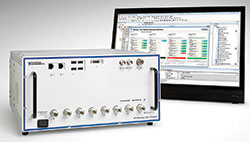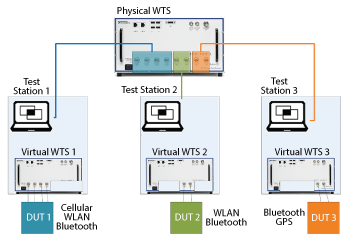
Earlier this year, Tesla Motors CEO Elon Musk commented that in the future, “people may outlaw driving cars because it’s too dangerous.” He was referring to autonomous-drive vehicles sharing the road with other human-controlled cars. Several companies are working toward a reality that envisions you sitting back and reading this magazine while your car transports you safely, comfortably and efficiently to your destination. While you are fully engrossed in the magazine article, your connected car is occupied with processing multiple streams of data from multiple sources, including an important rescheduling notice from the office, road traffic signs, highway warning systems and other vehicles in the vicinity.
Several key technologies will ultimately make this vision of the Internet of Things (IoT) or Internet of “Everything” possible. For instance, once it’s defined, next generation wireless infrastructure, or 5G, will provide a wider data pipe for a larger number of users, based on technologies like massive MIMO, higher frequency bands and new waveforms. Another enabling technology is the creation of more tightly integrated chips, modules and devices that combine wireless connectivity with greater processing power. These devices must support an expanding number of complex wireless standards on a growing collection of radio bands.
Having this kind of wireless connectivity in every device with which people interact forces the cost model of these devices to change. Although consumers have the expectation that devices purposely built for wireless networking – such as cellular phones, access points, and home monitoring systems – have a high price premium for this functionality, for other “things” that now connect to the Internet, consumers might not want to bear the extra cost. Although semiconductor system integration reduces the cost of component production, wireless devices manufacturers still have the costly burden of testing each one rapidly and reliably.
NI’s NEW WIRELESS TEST SYSTEM
NI recently released a new Wireless Test System (WTS) to address the need for a cost-effective test solution that can keep pace with evolving wireless technologies. Based on the PXI platform, the WTS uses a high bandwidth PXI chassis, a quad-core Intel i7 embedded PC and one or more of the award-winning NI vector signal transceivers (VST). This PXI configuration is internally connected to a rugged RF switch with 8 or 16 Type N RF ports. A metal enclosure makes the system robust enough to meet the demands of high volume production environments.
One of the unique features of the WTS is that you can remotely control it from a PC through a LAN bus using standard commands for programmable instruments (SCPI). With this architecture, the instrument uses a SCPI interpreter to decipher commands and apply the appropriate measurement software. WTS supports measurements for both cellular (from GSM to LTE-A) and wireless connectivity devices (WLAN and Bluetooth). The software algorithms for these measurements are identical to those of other PXI RF test configurations.
REDUCING TEST COST
In addition to the need for modern test systems to reduce capital expenditures, test engineers are required to maximize test throughput – often measured in number of devices tested per hour – and implement parallel test architectures and techniques, while simplifying test development efforts. Typically, test of wireless networking devices requires inserting and removing the device under test (DUT), booting up, configuring the DUT for every test step and performing measurements with the test instruments. In practice, the test system utilizes the RF instruments for only a fraction of the time when testing one device at a time. Given the complexity of wireless test plans for today’s devices, testing just one device is an inefficient use of the instruments. As a result, parallel test using a multi-port RF instrument is a common approach that can reduce measurement dead time by making sure that a given test site can access the RF instrument while the other sites are busy with non-measurement tasks. Although the idea of parallel test is simple in theory, implementing a parallel test approach greatly increases the complexity of the test solution.
For example, parallel test requires developers to write test sequences to control and intelligently synchronize both the instrument and the DUTs. Typical test sequences must be designed for multiple sites, keeping track of multiple instrument handles, signal routes and system variables. As a result, designing test software to implement parallel test is a daunting challenge.

Figure 1 Expanding the WTS into multiple virtualized instruments.
Although solving this challenge is difficult with traditional tools, the new WTS simplifies the process with several advanced software features. Two key features of the WTS that simplify parallel test development and make it more scalable are instrument virtualization and pre-coded test steps. Instrument virtualization allows a single WTS to appear – and be programmed as – multiple separate and independent instruments. Using this feature, test developers can write test sequences for a single DUT with their independent, virtualized instrument in mind (see Figure 1). A second key feature is the use of preconfigured test steps with integrated DUT control. These test steps are part of the new NI TestStand Wireless Test Module, an extension of TestStand, the industry-standard test management software. Using the Wireless Test Module, a developer can drag, drop and configure test steps to build a sequence for a single DUT (single site). When the Wireless Test Module executes the sequence, it automatically maps the WTS’ RF ports to multiple parallel and independent test sockets, each of which talks with its own virtualized WTS for multi-up DUT testing.
Implementing these techniques has already benefited the testing of intricate automotive infotainment modules that come equipped with multi-band, multi-standard cellular, WLAN and Bluetooth radios as well as GPS receivers, many from different device manufacturers. According to Harman International Industries, this novel approach to test their multi-radio infotainment modules with NI’s WTS allowed them to realize important test time reductions.
The WTS’ powerful PXI hardware platform in combination with its SCPI interface and intelligent software for implementing the latest cost-saving test architectures give manufacturers of wireless devices the flexibility to keep pace with the advances of the wireless test industry. Even more exciting, once 5G is defined, the combination of NI’s WTS instrument virtualization and the Wireless Test Module for test parallelization will enable test engineers to boost test throughput and ultimately lower the cost of testing mobile communications products and the wireless devices that will power the industrial and consumer Internet of Things. With this advance, we can look forward to a world where producing connected cars, homes and a variety of smart appliances is economically viable.
National Instruments
Austin, Texas
www.ni.com
